| To unsubscribe send us an email with the topic 'unsubscribe' |
| Hello. Only today. Price $190 |
| Databases 700million email addresses. All World. |
| No cheating. First a database, then money. |
| Write now and get a holiday discount. |
| email.business.group@gmail.com |
Friday, February 28, 2020
Hello. Only today Databases 700million email addresses.
Tuesday, February 25, 2020
Ep 22: Give Me Lead Til I’m Dead Is Live!
Sunday, February 23, 2020
Authentic Vs Epic
So, I tweeted out a poll last night. If you were DMing, would you rather go for authentic or epic?
Several people responded "both" or asked what the difference was or just needed clarification. My reply required more than Twitter's character limit could give me.
When I say "authentic" I mean a few things...
1) Realism: Yes, it's hard to talk about realism when we're dealing with sorcerers and dragons. Verisimilitude is probably closer to the mark. What would a genuine romp through the campaign setting look like? Sleeping on the ground, cooking beans and sausages in the fire, or the Disney version where sleeping arrangements aren't even considered because everyone's rushing from starship chase to disarming the nuclear fireball to dueling with the PCs' arch-nemesis.
2) The mundane stuff: Doesn't have to be all grim and gritty and covered in filth, but it shouldn't be super glamorous. The lived-in universe of Star Wars IV where Luke has to scrape off the carbon scoring by hand. That's not epic. Nor is cleaning bedpans, but someone's got to do it. Should the PCs? Well, not for the entire scenario, obviously. However, would it kill them to start their adventuring life mopping the tavern floor or chasing after poop-covered chickens?
3) Things just happen: Not much attention is paid to the beginning, middle, and end. No inciting incident, rising action, or climax. As you get deeper, things may get increasingly hairy, but that's just logical progression, not anything to do with a story arc.
When I'm talking about epic, I mean things that are larger than life and grandiose. Since I'm already on a Star Wars kick, the sequel trilogy (episodes VII - IX) would be epic. Humble beginnings quickly lead to whooping ass and taking names right in the middle of a galactic drama between good and evil (or what passes for such things).
If this were an epic D&D session, even meeting in a tavern would launch straight into a quest to save the kingdom or at least a princess. In contrast, an authentic session where PCs also meet in a tavern might escalate into a barroom brawl before overhearing that an entrance to the mythic underworld has just been found just outside town.
Epic goes for adventure with a capital A. Authentic reminds you that even if you score a decent haul of treasure, there's still a chance for catching a splinter while you're polishing the blacksmith's anvil, listening to the village idiot drone on about his imaginary cat.
And yes, there's a connection between authentic vs. epic and sandbox vs. pre-plotted linear adventure. The former moves along at it's own pace, organically... usually haphazard and occasionally awkward. The latter is sleek and stylish with thrills and chills at regular intervals, but let's face it, those adventures also feel kind of staged, plastic... artificial, even.
So, the big question! Are these mutually exclusive or can epic and authentic go together like chocolate and peanut butter? I'd say, yes, it's possible to do both. And yet, exceedingly rare is the Game Master who can consistently pull off authentic and epic in the same session. Campaigns are easier to manage authentic and epic because different adventures can provide for tonal shifts. Even the farm boy from Tatooine can blow up a Death Star after 10 sessions of hard work.
In the end, I, too, prefer both. However, if I had to set my sights on just one... it would be authentic because that gets you closer to immersion, which is the prime factor of roleplaying games.
VS
p.s. Want the Cha'alt hardcover? Due to high demand, I've decided to extend the special January deal until Valentine's Day... while supplies last!
Saturday, February 22, 2020
Final Fantasy 5 Book
I was able to get a copy myself on Kindle, and for anyone who was a fan of Square's 16 bit gem, I would highly recommend it.
The book is also interesting inasmuch as it is framed though the biographical details of the life of its author- Chris Kohler, of fame to many in the retro game world (through his contributions to the podcast Retronauts and his other authored works) and also the world of trivia (through his membership of the trivia panel in the podcast Good Job Brain).
Who would have thought that Chris Kohler would have had so much involvement in the original gang of Geeks that fan translated FFV in the early days of the internet, and yet that is what this book reveals, he even was part of the team that produced the first English FAQ! And so the guy has some really interesting bits of information to share on the game, its development and on its reception via emulation world.
The book also shows how FFV has become even more popular in the world of internet 2.0 as fans challenge each other with scenarios like- "beat the game with 4 nijas" or "no mages allowed", reading about their adventures actually got me to boot the game up once again and begin a play though.
So thanks to Fr. Mark Higgins for the head's up, if anyone else has spotted a book, game or podcast that might be of interest to me as Catholic gamer and a classic RPG fan, do let me know.
Friday, February 21, 2020
Missed Classic 80: The Price Of Magik (1986) - Introduction
 |
| Magik witk k, bekause it sounds kool? |
I said an, not the end. With these two games, a certain phase in the development of Level 9 is coming to a close. Looking back at all the products of Level 9 I've played, it seems that their most creative phase was with their four first games. Their first game, Colossal Adventure, itself mostly just a feat of importing an existing game from mainframe to PC, served as a template for all their Treasure Hunts, by which I mean a game where the main goal (aside from possible end sequence) is to maximize your score by collecting as many treasure items as possible (treasure items being usually, but not always, of no use beyond their role as treasure). The most perfect example of a Treasure Hunt in Level 9 collection was their third game, Dungeon Adventure, which.got rid of everything superfluous, like end sequences, and concentrated on looting treasures within the most fiendish puzzle box the developers could think of.
The second Level 9 game, Adventure Quest, could be said to form a template of Travel Story, where plot progression means basically advancement into a new map area (although backtracking might be allowed) and where main goal is to get to the final room (and possibly carry something into the final room or do something there). Travel stories Level 9 perfected with their fourth game, Snowball, where you have to move through a spaceship full of dangers into the final room where a terrorist is hiding with a bomb.
After this first round of creativity, the development of Level 9 games has been mostly technical - they added pictures and streamlined their parser - while most of their games still used the two templates. Lords of Time, Emerald Isle and Red Moon were again Treasure Hunts, although two of them tried to hide this fact with a meatier plot. Return to Eden, on the other hand, was like a bad parody of a travel story, with player walking through disconnected areas containing various threats to a trial, which they will lose unless they carry the right items with them.
This doesn't mean Level 9 had completely stopped innovating. Interestingly, their imaginative side showed most with their games made for Mosaic. Partly these innovations must have been caused by a desire to make easier games. This is especially true with their take on CYOA genre, where The Secret Diary of Adrian Mole served as template and The Archers brought that template to fruition, especially by making the point system of the first game more sensible and giving real options for the player.
A more interesting novelty was what I could call a Game of Exploration, to which The Saga of Erik the Viking served as the template. The idea behind the name is simple. After a short introductory sequence, game world - big, but empty, as has been the case with Level 9 games - opens up almost completely, with only few hidden and/or closed spots. The task of the player is to explore this world, with no real idea what to look for (there are even no treasures to be discovered), and find the key items required for triggering the end game. This template was perfected in The Worm in Paradise, where the dystopian-bureaucratic context and the amnesia of the player character made the mindless exploration understandable.
The reason of this long prologue is that I feel The Price of Magik falls squarely into the Exploration type. It at first seems like it would be another Travel Story, but then… and now I am getting ahead of myself.
 |
| First few rooms |
Let's begin with the premise of the game. The Price of Magik continues the story of Red Moon, which was basically a tale of finding a stolen artifact (titular Red Moon of Baskalos), which was the source of all magik. In this game, the artifact is stolen again! The supposed guardian of the Red Moon, Myglar, wanted to make himself immortal and channeled all its energy to this task. Because of this, Red Moon is about to fade and magik will disappear.
Manual reveals also that the player was transferred to the House of the Red Moon magikally, after blowing and exploding a big red balloon found in an attic. I have a feeling nothing at all will be heard about this story in the game itself.
At the beginning of the game I found myself at the driveway outside the yard. There was a woodshed, leading to a herb garden, each containing a number of objects, some of which required some small scale puzzle solving (for instance, I could use a candle to burn a pile of wood into ashes).
The house itself could be entered from two directions - through the front door or by climbing a vine to the attic. It was completely dark inside, but herb garden had contained some eyebright flowers, which were said to miraculously improve vision when rubbed into your eyes.
Let's start describing the house itself from the top. There was a small attic, consisting only of few rooms. Among other things, the attic contained a mirror, which I could cut to pieces with a diamond ring. Beyond the mirror I found a prism, which had the word XAM written on it.
 |
| The attic |
This is the perfect time to speak of the magic system. Just like in Red Moon, you need two things for doing magic - spell word and corresponding focus. In Red Moon, the spell words, the required foci and the effects of each spell were described in the manual. No such luck here. Spell words - always consisting of three letters - are scattered around the game world, for instance, examining the knocker at the front door revealed the word ESP. Helpfully, if you try to cast a spell, but you don't yet have the focus, the game will tell you what focus you'll need.
Spell words seems to have some relation to the effects - you could think XAM might be about examining and ESP about telepathy - but it needs some research to verify what a spell actually does. As a book found within the house has told me, the game has three kinds of spells - spells you just cast generally, spells you cast to some direction and spells that you cast at some object/character (player included).
Interestingly, magic affects your characteristics. You start the game from the ripe age of 20, and each spell you cast makes you older - when you turn 100, you die. Magic is also connected to your sanity - the less sane you are, the more power your casting has. Naturally you want to reduce your sanity as much as you can, so how do you do it? Well, finding spell words and foci and casting spells for the first time does this. In addition, there are other events that shake your sanity - for instance, if you knock on front door, some nameless monster appears for a second and frightens you.
So, you'd think the game would be spent in searching new spell words and foci. Yet, the very first spell I found changed this radically - when I used XAM at any focus, I would learn what spell it was a focus for, thus making all spell words hidden in the house redundant. I then quickly learned that one focus - a piece of mirror I had just acquired - changed the game even more radically. The mirror let me cast ZEN, which gave me access to "mists of time", which was essentially just a quick way to access nearly all of the map and even places that at this point would have otherwise been closed off from me (changing this from Travel Story to a Game of Exploration).
I decided I wanted to play this game more organically, learning spell words as I discovered them in the house and accessing new places only after I had solved the necessary puzzles (like Captain Kirk said, we are meant to fight our way through and claw every inch, not stroll to the sound of flutes). Back to mapping, then. Since most of this was pretty humdrum, I'll try to be terse, indicating only the more interesting things I found and puzzles I solved.
 |
| My very own sidekick |
The most interesting thing in the second floor was a bat that started to follow me. It took me a while to get this, but the HYP(nosis) spell let me command creatures. When I HYPnotized the fellow, it helped me to catch a moving wheel (another focus). Other puzzles on this floor were simple, once I found proper spells. There was one secret room containing lever, pulling of which released a sword. I also found an inscription of a spell on a roof, which I could read only by using the spell FLY on myself.
 |
| Second floor |
Finally, there was a room full of chests of many different colours. Opening up a wrong one created an explosion that hurt my stamina. It all came down to using the DOW spell - meant for checking if an item is magical - to find the one I could open safely, Inside, I found some salt.
 |
| I really don't want to know what's going on here... |
The bottom floor was the largest in the house. The most remarkable thing I found in it was the Red Moon I supposed I was searching for. I couldn't take it, because its magic gave me a jolt, but touching it rejuvenated me, making my age quite irrelevant. I also could levitate the Red Moon with my FLY spell, revealing yet another spell word (DED).
 |
| Partial map of the first floor |
In addition, I met a ghost, who was willing to give me its old armour, if I just buried all his bones, scattered in few places. I had already found a shovel, and a good burial place was in the garden.
I also met my first hostile creatures: werewolf, wight, skeleton and a giant slug. The game has a combat system, but just like in Red Moon, I assume it's completely useless. Indeed, I could walk around the wight, the skeleton wandered from one room to another and the wolf was scared of wolfsbane. And the slug? It didn't like salt.
Beyond the slug opened up a whole new, underground section of the game. Having now searched through the house proper, I think it's best to end the post. The main problem, as in many earlier Level 9 games, is that the game world is too sparse in comparison with its size - I've spent most of time mapping, instead of solving puzzles.
Spells (if I've "officially" found them) - foci (if I own them) - what they do: ESP - ? - ?, ? - candle - ?, ? - ashes - ?, DET - elder cross - detect danger, XAM - prism - checks if target is focus for some spell, ZEN - mirror - rapid movement, MAD - grimoire - make target mad, HYP - staff - hypnotises targets, ? - valerian - ?, DED - wheel - cancels spells, FLY- broom - makes target fly, DOW - pendulum - check if target is magical, BOM - ? - ?, SEE - feldspar lense - finding secret doors
Inventory otherwise: mandrake, skull, knucklebone, ring, eyebright flowers, cage, robes, knife, wolfsbane, shovel, plate armour
Battle Of Quinto 1937 - AAR
This is the after action report for our recent Battle of Quinto game, a part of a large scale offensive by the Republican Forces during the larger Belchite offensive in the Spanish Civil War, the original Scenario and background report can be accessed on the link below,
https://yarkshiregamer.blogspot.com/2019/07/battle-of-quinto-1937-scenario.html
So here is the game report told mostly through photos taken during the game.
So if you're familiar with the background of the game from the link above you will know that the Republican Forces are "tanked" up so the Nationalists used their initial reinforcement pot on some Anti Tank capability.
Air Support is random in the game but we seemed to be inundated at the start of the game here the Republicans use their planes to attack the Falange positions on the Purburel.
The Nationalist Air Force must have been on some performance enhancing drugs to begin with as their aircraft turned up 5 turns in a row, that's a 1 in 100,000 chance.
The Carlists set up camp in the Cemetery but come under heavy fire from the Republicans.
The Nationalist Air onslaught continues but on this occasion the bombs fall short of the T26 which was attacking the Cemetery.
But it wasn't all Francos boys, the Republicans had spent their Pesetas on a Maxim and were pouring fire into the Carlist Infantry.
Opposite the Purburel International Brigaders were massing in the woods to launch and attack on the Falange.
Sensing the attack was coming a unit of regular Nationalist Infantry rushed to reinforce the Falange, who had already taken a number of casualties from air attack and long range infantry fire (Yes I know they are Legion, I haven't got any Regular Infantry figures, yet).
The centre of the battlefield was relatively quiet, the Lincoln Battalion had some decent cover and with the player covering that sector absent the other Republican Generals banked the Lincolns money and concentrated on their own attacks.
Meanwhile back at the Cemetery, Republican Assaltos are massing for an attack on the Cemetery but the Carlist General has invested in a Field Gun which is starting to find it's range.
With the Carlist unit in the Cemetery wiped out a lone Dynamitaero rushes the T26, throws his bomb, but it misses, landing on the roof of the nearby building.
But the hand of fate falls kindly for the lone Nationalist as he activates first in the next turn and lands a bomb on the tanks turret rendering it useless.
Back on the Purburel an unfortunate morale check pins the Nationalist Infantry allowing the Brigadista to charge forward and after a fierce hand to hand combat take the position.
There is chaos of a different kind in the centre of the table as a Random Event Card sets loose a Crazed Bull, look out boys he ain't happy, he is heavy !
Having taken out 4 Assaltos the bull fronts up a HMG and some dug in Republicans before an Artillery round scares him off.
Things start to sway the Republican way, here we see two Dynamitaroes charging Quinto Church, there explosive charges clearing the building and giving them a foothold in the town.
Buying Panzer Is proved to be a bit of a dud investment as one is taken out at long range by a T26 whilst guarding Quinto Station.
Sensing a change in the wind (and the end of the game) the Republicans threw everything forward.
But in one of those random twists of fate a Nationalist Artillery Shell over shot the position on the Purburel and landed on top of a truck bringing ammunition supplies to the front line leaving all the troops on that side of the table short of bullets for the coming attack. The extended supply lines for the Republican Forces as they advanced proving a real issue.
A newly arrived International Brigade Battalion pushed forward to support the remnants of the Assaltos in the Cemetery and Church, supported by a HMG.
Timely arrival of a Republican Air Raid on Quinto Train Station gave hope to the attack of the POUM and the Brigadista.
But it is a strong defensive position and the Republicans miss an opportunity when an event card stops fire for the turn, they sit still rather than take advantage of a free (from casualties) move forward.
As they surge forward the next turn they come under heavy fire, crossing open ground is never easy.
The Carlists left in Quinto take to the rooftops to pour fire on the advancing enemy.
Sadly for the Republican Generals the attack of the Lincoln Battalion in the centre is stopped just short of Las Eras.
Likewise the attack on the Train Station is stopped by shear weight of fire.
The British Battalion however managed to consolidate its position and began to dig in around the Cemetery,
We called the game at that point with a Nationalist Victory, they had held onto the majority of the town, however full credit must go to the Republican Forces as they broke through the first line of Nationalist positions and who knows if extra pressure had been put on the centre early on it might have been a different story.
 |
| A now calm bull reads the Church notices |
Thursday, February 20, 2020
Improving The 2D Noise Page
One of my goals for 2019 is to improve my existing pages. Yesterday I decided to work on my old 2D noise page. We normally use Perlin/Simplex noise to make terrain heightmaps, but on that page I used Fourier transforms instead. Perlin/Simplex noise are a fast approximation of the things you can get from Fourier transforms.
The 3D renderer on that page always bothered me. It was one of my early experiments with WebGL. I had never been able to figure out exactly what I didn't like or how to fix it.
I decided to improve the renderer.
I read through the code to and realized it was written so long ago that let and const weren't even widely available! I started by updating the code style to match the code I write today. I read through the rendering code and decided to switch from raw WebGL to regl.js, which lets me experiment and iterate much more quickly.
I wanted to compare the old and new output easily, so I put them side by side on the page. I wanted to try two techniques with the new renderer:
- Instead of building a new 3D quad mesh on the CPU every time the data changed, I built a single 2D triangle mesh with x,y, and then read the heightmap data from a texture on the GPU. Reading textures from vertex shaders is widely supported now. This way, I only have to update the texture on each render instead of rebuilding the mesh. Unfortunately I couldn't figure out why it wasn't interpolating pixels values; I had to put in my own interpolation.
- Instead of calculating normals and lighting on the CPU every frame, I calculated them in the fragment shader on the GPU. But I didn't want to use a standard lighting system; I wanted to apply outlines instead. I had learned how to do this in mapgen4 and wanted to try an even simpler approach here. This worked out really well.
In this comparison you can see how the dark/light spots in the noise are renderered in the two renderers. With the old renderer (green) the color changes but the shapes are all mushy. With the new renderer (gray) the dark/light matches the noise, and the mountain peaks are easier to see.
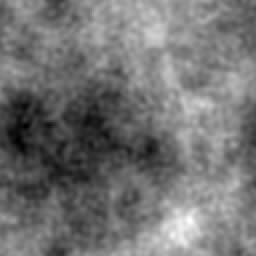
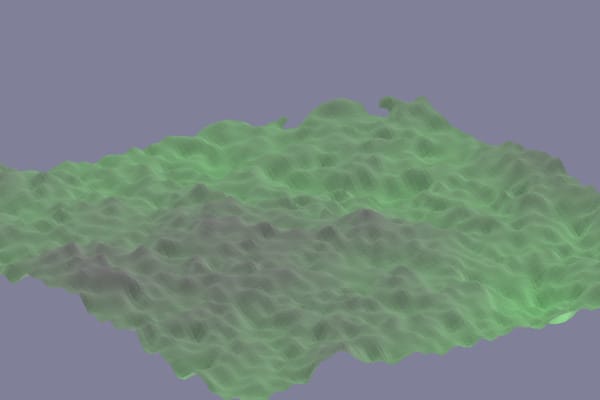
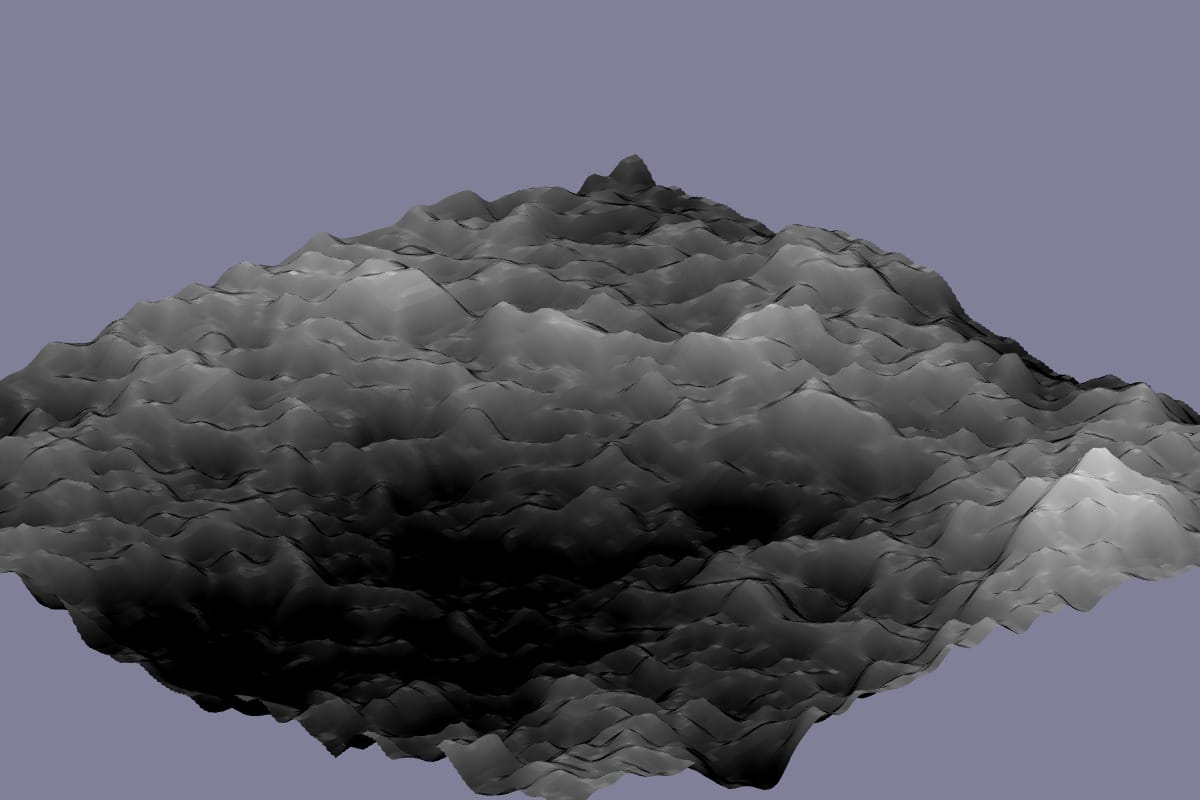
In smooth areas you can see how the outlines help show the shapes. You can also see that the old renderer flipped the elevation upside down (oops!).

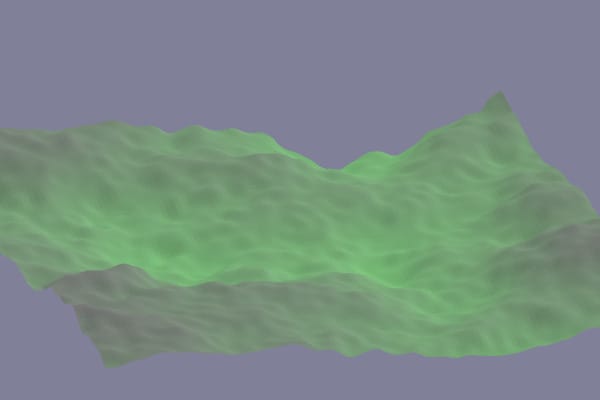
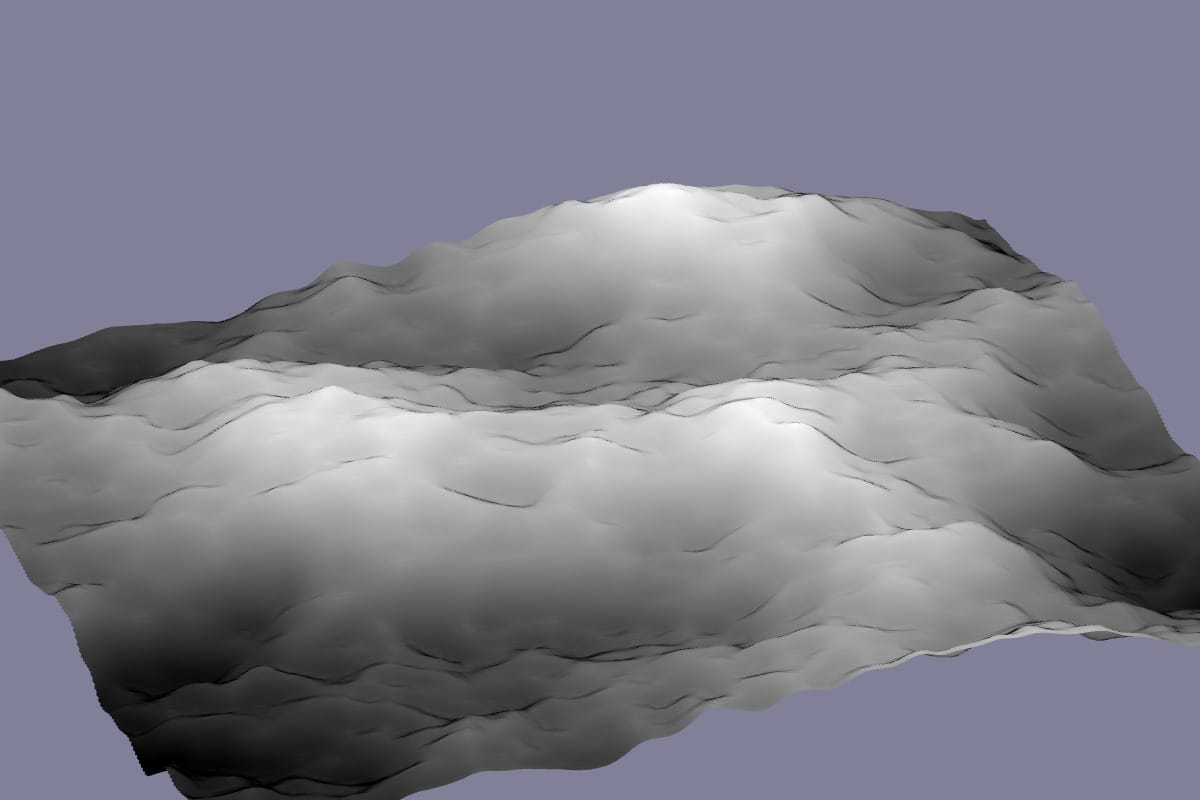
With blue noise (positive exponents) the new renderer looks much better:
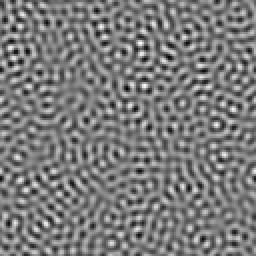
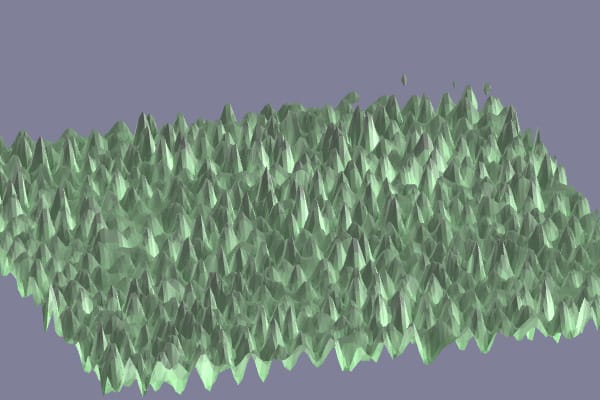
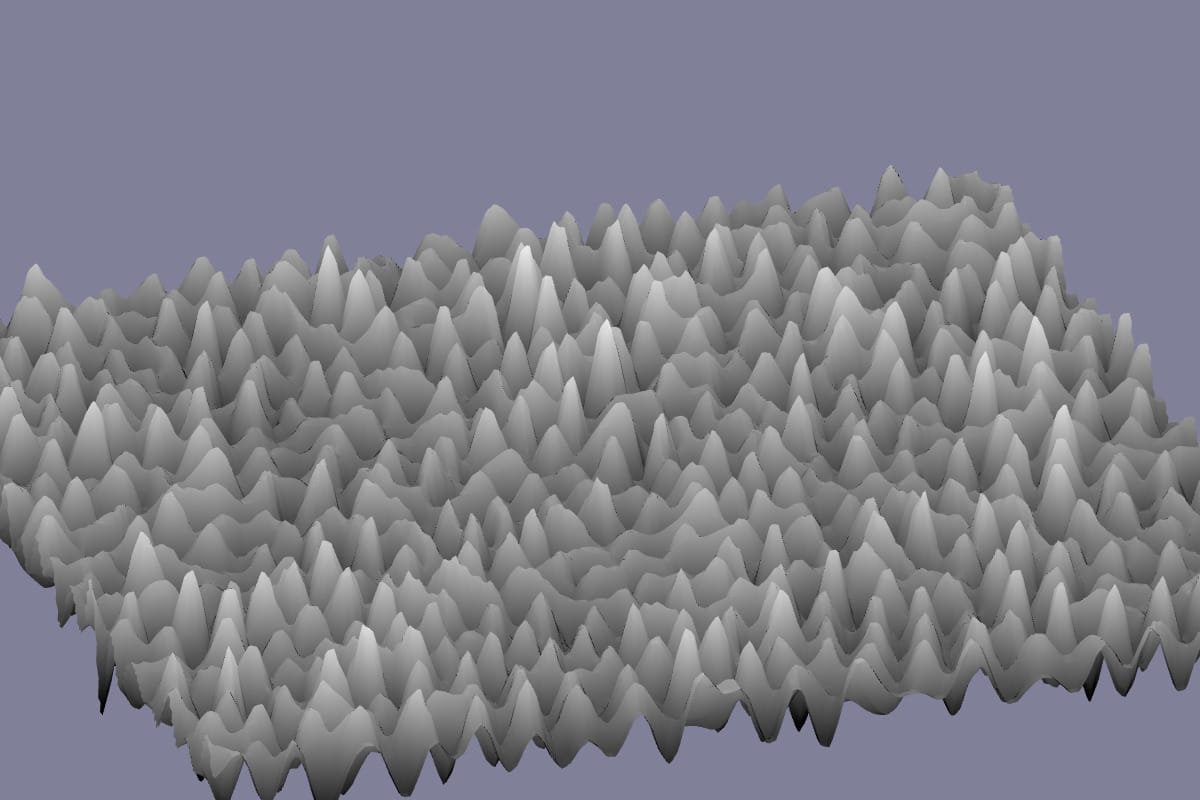
I'm really really happy with outlines! Compare:
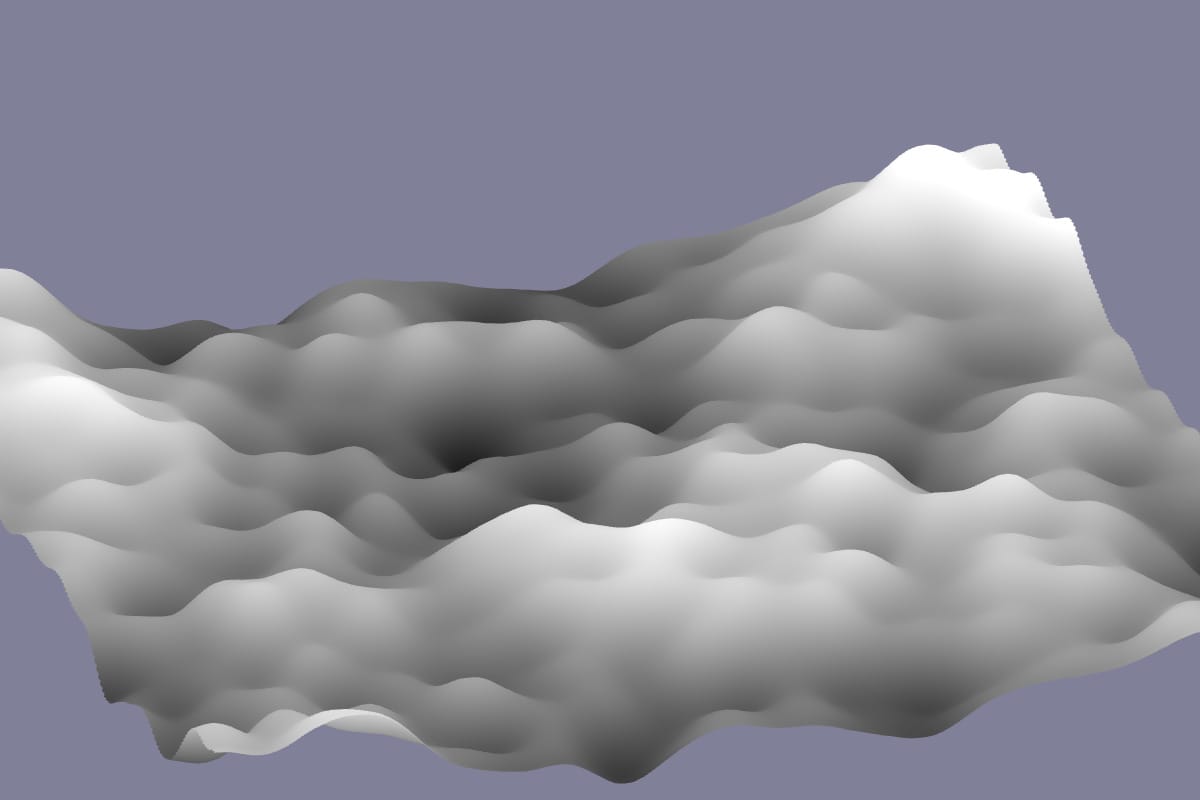
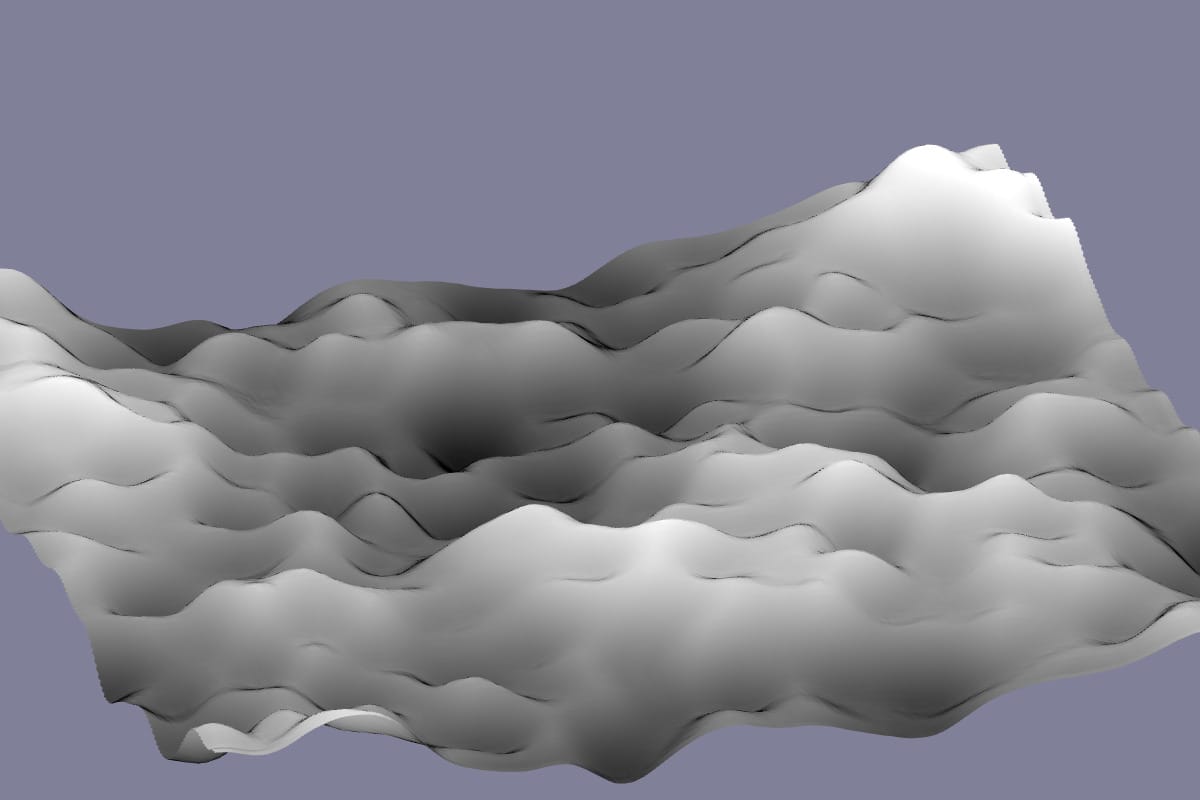
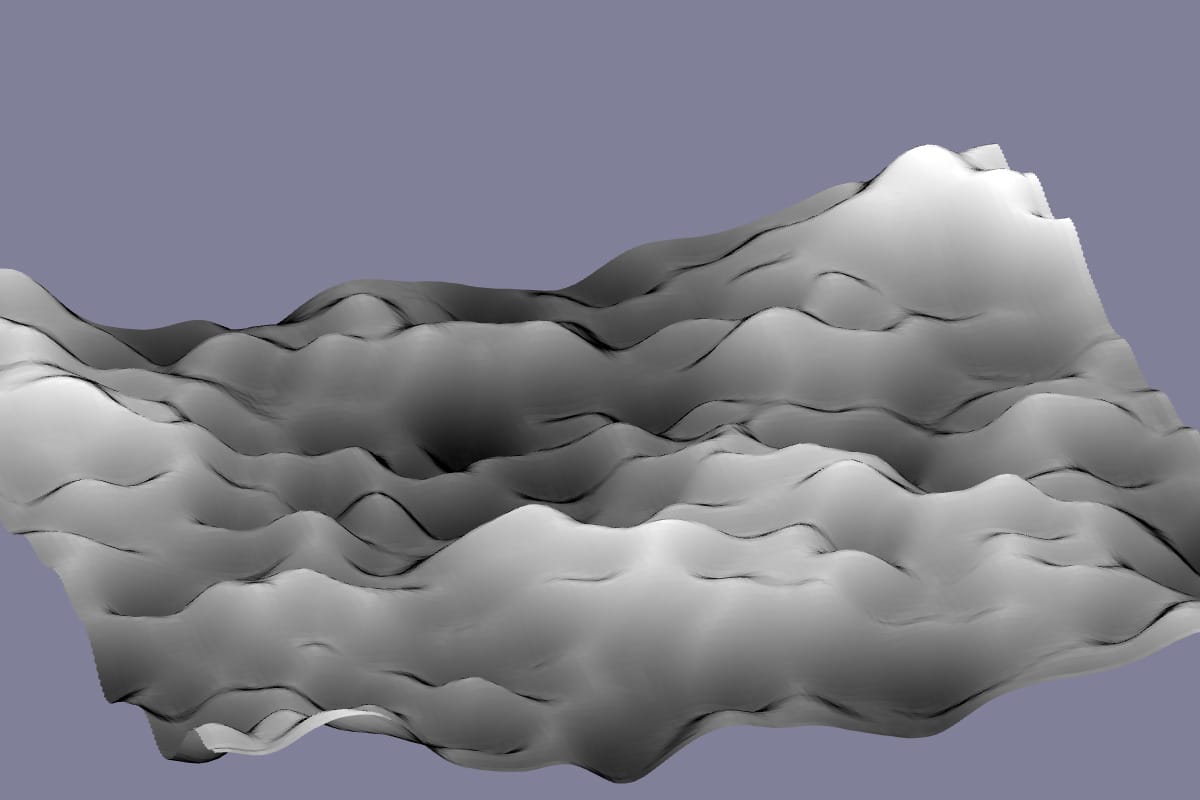
The outlines are one line of code:
void main() { float light = 0.1 + z - fwidth(z) * u_outline; gl_FragColor = vec4(light, light, light, 1); } I darken the color based on fwidth(z). The GL extension OES_standard_derivatives calculates how much an expression changes from the current pixel(fragment) to adjacent pixels. When z changes a lot, that usually means it's changing from one mountain peak to another, so I darken the output color.
There are still more things I'd like to improve on this page, but the renderer was the thing that bothered me the most, and I'm now happy with it. The other changes will wait until another day.






































